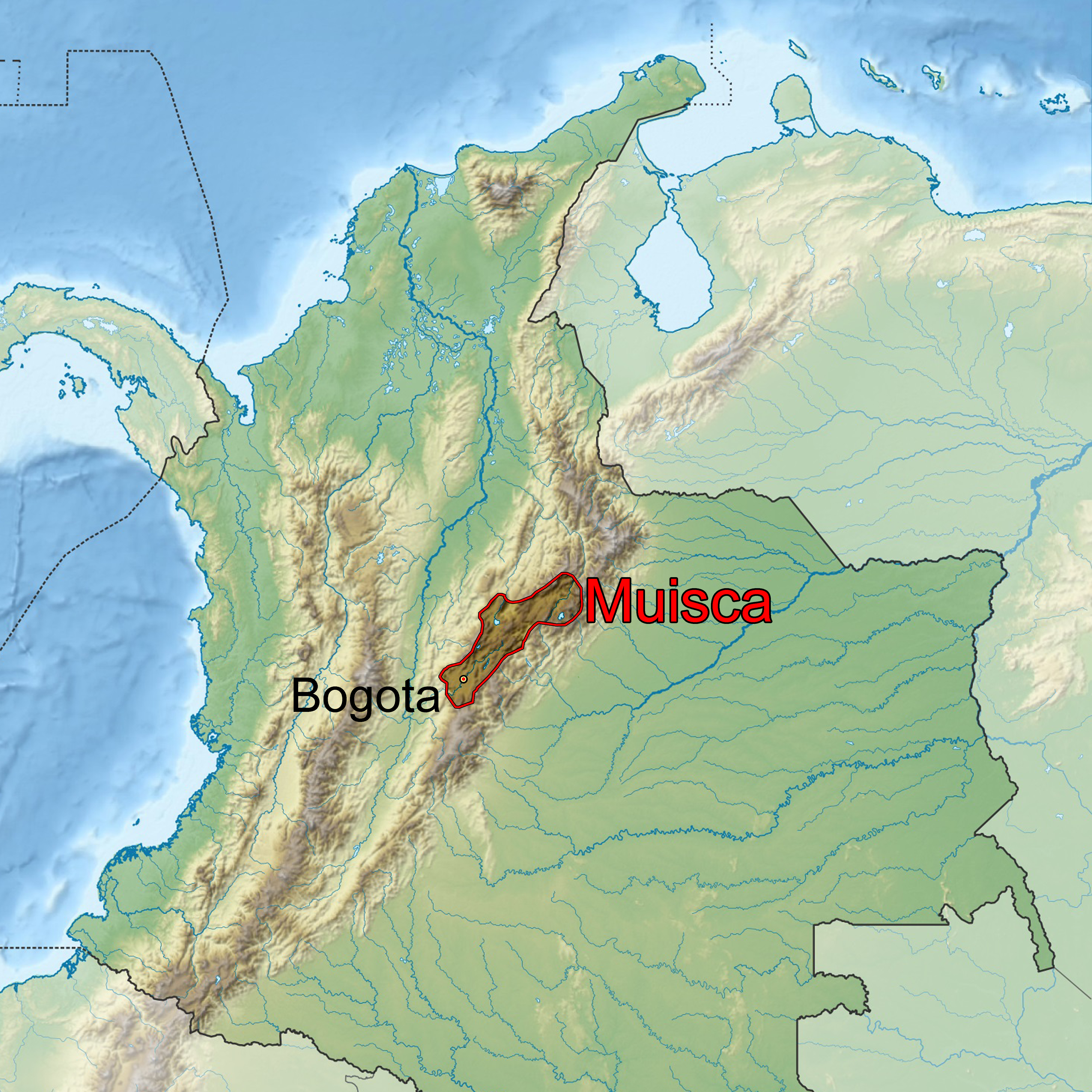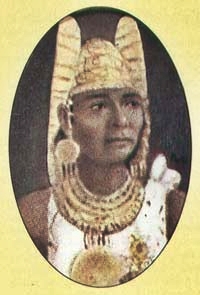|
Zaque
When the Spanish arrived in the central Colombian highlands, the region was organized into the Muisca Confederation, which had two rulers; the ''Zipa'' was the ruler of the southern part and based in Muyquytá. The ''Zaque'' was the ruler of the northern area and based in Hunza, known today as Tunja. Organization ''Zipa (Psihipqua)'' and ''Zaque (Hoa)'' were the titles given to these rulers of the ancient confederation. Neither exercised absolute power, not rigid or strict control over those to whom they owed their power, so that they can be considered kings. However, these positions of power were of great honor and were surrounded by a rather elaborate ceremony. The position of the ''Zipa'' was such that not even the members of the nobility dared to look him in the face, and it is said if the ''Zipa'' needed to spit, someone would hold out a piece of rich cloth for him to spit on, because it would be sacrilegious for anything so precious as his saliva to touch the ground. Wh ... [...More Info...] [...Related Items...] OR: [Wikipedia] [Google] [Baidu] |
Muisca Confederation
The Muisca Confederation was a loose confederation of different Muisca rulers (''zaques'', ''zipas'', ''iraca'', and ''tundama'') in the central Andes, Andean highlands of what is today Colombia before the Spanish conquest of the Americas, Spanish conquest of northern South America. The area, presently called Altiplano Cundiboyacense, comprised the current departments of Colombia, departments of Boyacá Department, Boyacá, Cundinamarca Department, Cundinamarca and minor parts of Santander Department, Santander. According to some List of Muisca scholars, Muisca scholars the Muisca Confederation was one of the best-organized confederations of tribes on the South American continent. Other Historian, historians and anthropologists, however, such as Jorge Gamboa Mendoza, attribute the present-day knowledge about the confederation and its organization more to a reflection by Spanish chroniclers who predominantly wrote about it a century or more after the Muisca were conquered and propo ... [...More Info...] [...Related Items...] OR: [Wikipedia] [Google] [Baidu] |
Muisca People
The Muisca (also called the Chibcha) are indigenous peoples in Colombia and were a Pre-Columbian culture of the Altiplano Cundiboyacense that formed the Muisca Confederation before the Spanish colonization of the Americas. The Muisca speak Muysccubun, a language of the Chibchan language family, also called ''Muysca'' and ''Mosca''. The first known contact with Europeans in the region was in 1537 during the Spanish conquest of New Granada. In New Spain, Spanish clerics and civil officials had a major impact on the Muisca, attempting to Christianize and incorporate them into the Spanish Empire as subjects. Postconquest Muisca culture underwent significant changes due to the establishment of the New Kingdom of Granada. Sources for the Muisca are far less abundant than for the Aztec Empire of Mesoamerica or the Inca Empire and their incorporation to the Spanish Empire during the colonial era. In the New Kingdom of Granada and into the colonial era, the Muisca became " ... [...More Info...] [...Related Items...] OR: [Wikipedia] [Google] [Baidu] |
Tunja
Tunja () is a municipality and city on the Eastern Ranges of the Colombian Andes, in the region known as the Altiplano Cundiboyacense, 130 km northeast of Bogotá. In 2018 the municipality had a population of 172,548. It is the capital of Boyacá department and the Central Boyacá Province. Tunja is an important educational centre of well-known universities. In the time before the Spanish conquest of the Muisca, there was an indigenous settlement, called Hunza, seat of the ''hoa'' Eucaneme, conquered by the Spanish conquistadors on August 20, 1537. The Spanish city was founded by captain Gonzalo Suárez Rendón on August 6, 1539, exactly one year after the capital Santafé de Bogotá. The city hosts the most remaining Muisca architecture: Hunzahúa Well, Goranchacha Temple and Cojines del Zaque. Tunja is a tourist destination, especially for religious colonial architecture, with the Casa Fundador Gonzalo Suárez Rendón recognized as the oldest remnant. In addition ... [...More Info...] [...Related Items...] OR: [Wikipedia] [Google] [Baidu] |
Hunzahúa
Hunzahúa was the first ''zaque''; ruler of the northern Muisca people, Muisca with capital Tunja, Hunza, named after him. His contemporary ''zipa'' of the southern Muisca was Meicuchuca. Biography Hunzahúa, heir of Idacansás, was a ''cacique'' in the sacred valley of the ''iraca'' and was chosen by the other ''caciques'' of the region to make peace between the battling parties. He became the first ''zaque'' of the northern Muisca region based in Hunza, present-day Tunja, and one of his policies was the ban on the use of weapons. According to List of Muisca scholars, Muisca scholar Javier Ocampo López, who wrote extensively about the Muisca religion, religion and Muisca mythology, mythology of the Muisca, his mother was named Faravita and his sister Noncetá. Legend tells that Hunzahúa fell in love with his older sister and made her his wife when he left Hunza for Chipatá, Santander, Chipatá. Faravita, the mother of the ''zaque'', disagreed with the marriage of her two child ... [...More Info...] [...Related Items...] OR: [Wikipedia] [Google] [Baidu] |
Michuá
Michuá or Michica (died Chocontá, 1490) was the second ''zaque'' of Hunza, currently known as Tunja, as of 1470. His contemporary enemy ''zipa'' of the southern Muisca was Saguamanchica. Biography Little is known about the history of Michuá, who accessed the throne of the northern Muisca in 1470. He broke the political peace established under his predecessor Hunzahúa and fought a 16-year war with the southern enemies led by Saguamanchica. The latter, supported by his vassal Pasca conquered Fusagasugá and Tibacuy. Saguamanchica attempted to submit the ''cacique'' of Guatavita who asked Michúa for assistance. Michuá sent a messenger to Bacatá to negotiate the ''zipa'' would listen to the complaints of the ''cacique''. Saguamanchica was not amused by undermining his authority and abused the messenger. When Michuá found out about the mistreatment of his messenger he sent an army of forty thousand guecha warriors to the ''zipa''. Realising the strength of the army Saguam ... [...More Info...] [...Related Items...] OR: [Wikipedia] [Google] [Baidu] |
Battle Of Chocontá
The Battle of Chocontá was one of a series of battles in the ongoing conflict between the northern and southern Muisca of pre-Columbian central Colombia. The battle was fought 1490 in the vicinity of Chocontá. An army of 50,000 southern Muisca guecha warriors, led by their ruler, or ''zipa'', Saguamanchica, attacked 60,000 northern Muisca troops commanded by Zaque Michuá, who was supported by the Cacique of Guatavita. Background In the decades before the Spanish conquistadors arrived in the central highlands of Colombia in 1537, the area was ruled by two main groups: the ''zacazgo'' of the northern Muisca and the ''zipazgo'' of the southern Muisca. While the two factions were joined in a confederation, they fought numerous wars to conquer terrain and to gain access to the resources of the area, mainly gold, copper, and emeralds. The northern Muisca inhabited the area of the current department of Boyacá while the southern Muisca lived in the present-day Cundinamar ... [...More Info...] [...Related Items...] OR: [Wikipedia] [Google] [Baidu] |
Nemequene
Nemequene or Nemeguene (died 1514) was the third ruler (''zipa'') of Bacatá as of 1490. His '' zaque'' counterpart ruling over the northern area of the Muisca territory was Quemuenchatocha. Etymology Nemequene in the Chibcha language of the Muisca has two possible meanings, derived from the words ''nymy'', " jaguar" and ''quyne'', meaning either "bone" or "force". Biography Nemequene succeeded to the throne of the southern Muisca in 1490 after the death of his predecessor Saguamanchica in the Battle of Chocontá where the ''zaque'' of the northern Muisca Michuá had also died. While Nemequene wanted to continue the attacks against the northern Muisca, he had to face the dangers of the Panche to the west of his territory. Nemequene installed his nephew and legal successor Tisquesusa as army general to fight off the Panche with success. Looking to expand the territory of the southern Muisca, Nemequene succeeded in the conquest of other areas in the central highlands o ... [...More Info...] [...Related Items...] OR: [Wikipedia] [Google] [Baidu] |
Saguamanchica
Saguamanchica (died Chocontá, 1490) was the second ruler (''zipa'') of Muyquytá, as of 1470. His '' zaque'' enemy ruling over the northern area of the Muisca territory was Michuá. Alternative spellings of his name are Sacuan Machica, Saguanmachica and Saguanmanchica. Biography As former ''cacique'' of Chía, Saguamanchica accessed the throne of the southern Muisca around 1470. His predecessor, the first ''zipa'' of Muyquytá Meicuchuca, left him a rich kingdom with many guecha warriors. This led Saguamanchica to seek expansion of his ''zipazgo''. The first campaign of warfare he planned was to submit the eternal enemies of the Muisca, the Panche and the Sutagao to the west of the Muisca territories. The Carib-speaking peoples formed an alliance against their common and far outnumbered enemy. Saguamanchica together with his vassal A vassal or liege subject is a person regarded as having a mutual obligation to a lord or monarch, in the context of the feudal sy ... [...More Info...] [...Related Items...] OR: [Wikipedia] [Google] [Baidu] |
Bogotá
Bogotá (, also , , ), officially Bogotá, Distrito Capital, abbreviated Bogotá, D.C., and formerly known as Santa Fe de Bogotá (; ) during the Spanish Imperial period and between 1991 and 2000, is the capital city, capital and largest city of Colombia, and one of the List of largest cities, largest cities in the world. The city is administered as the Capital District, as well as the capital of, though not politically part of, the surrounding department of Cundinamarca Department, Cundinamarca. Bogotá is a territorial entity of the first order, with the same administrative status as the departments of Colombia. It is the main political, economic, administrative, industrial, cultural, aeronautical, technological, scientific, medical and educational center of the country and northern South America. Bogotá was founded as the capital of the New Kingdom of Granada on 6 August 1538 by Spanish conquistador Gonzalo Jiménez de Quesada after a harsh Spanish conquest of the Muisca, e ... [...More Info...] [...Related Items...] OR: [Wikipedia] [Google] [Baidu] |
Meicuchuca
Meicuchuca (died 1470) was the first ruler (''zipa'') of Bacatá, as of around 1450. His '' zaque'' counterpart ruling over the northern area of the Muisca territory was Hunzahúa. Biography Little is known about Meicuchuca and many stories about his reign are more mythical than historical. He ruled the southern Muisca territory from around 1450 to 1470 and was succeeded according to Muisca heritage laws by his nephew Saguamanchica. Meicuchuca and the snake The legend of Meicuchuca and the snake tells the story of the ''zipa'' who already had many wives. Polygamy was common practice with the Muisca and the higher the rank, the more wives could be held. The highest position of ''zipa'' could allow to have and sustain 300 wives, while the lower rank ''cacique'' "only" made 100 wives possible. Meicuchuca allegedly fell in love with a woman outside of the Muisca community. He only had eye for her and spent day and night with the beautiful stranger, forgetting all his other wiv ... [...More Info...] [...Related Items...] OR: [Wikipedia] [Google] [Baidu] |





